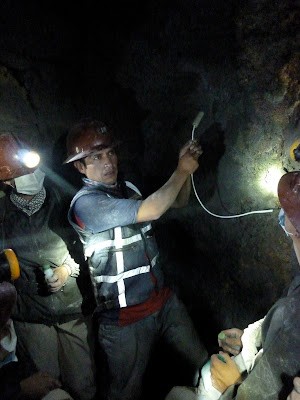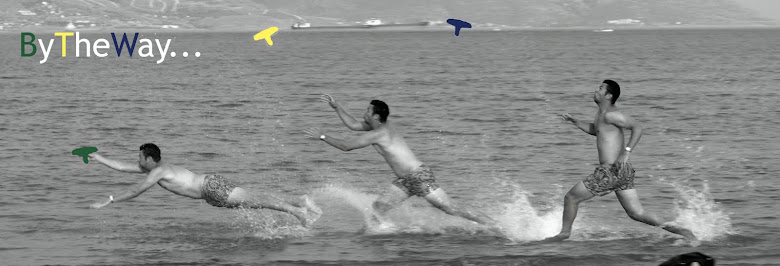 |
| Route so far. To be continued after New Year |
Bonito, Brazil
Having left the wetlands of the Pantanal at the beginning of December, I ventured south to Bonito, a small town with crystal-clear rivers, tropical fish and caves with ice-blue underwater lakes as its main attractions. Rappelling down on a rope seventy meters at 8am into a pitch black cave was certainly an awakening experience. Once safely down with the adrenal glands working overtime, the scale of the cave was barely visible with the water only noticeable through its slapping of the cave walls. Twenty minutes later, the first single ray of sunlight shone through from the ground level opening, illuminating a protruding stalagmite on the water's surface. A pretty incredible scene.
| Ready for the 70 meter drop |
| First ray of sunlight entering into cave |
Sucre, Bolivia
Getting to Sucre from Brazil was quite a mission, all in all a 36 hour journey, including a 12-hour overnight bus journey through Bolivia as the only gringo aboard. Thoughts of taking out the laptop to watch a movie quickly disappeared when I crossed from Brazil over the Bolivian border, where the living standards seemed to have dropped off a cliff. There was a noticeable change in appearances from facial features, clothes, cleanliness, as well as prices which were significantly cheaper in Bolivia (university costs 5 USD a year, as does a decent three course meal). Despite having S America's largest quantity of natural resources, it is the continent's poorest country. The Spanish robbed Bolivia of its pure silver used to bankroll its growing new world empire, while decades of government mismanagement of its resources has left a majority of the 9 million in poverty. Bolivia, now landlocked and bordering Peru, Chile, Brazil, Paraguay and Argentina lost half its territories to its neighbours over the past century.
Sucre is Bolivia's judicial capital, the site of Bolivia's liberation and once political capital that is now La Paz, further North. It's a nice colonial city, and a perfect backpacker's hangout. I spent two days hiking in the surrounding mountains with a guide following an Inca trail and reaching 3,600 meters. We overnighted in a very basic hut open to hikers to wonder in and part of a town nestled in the bottom of a crater. The second day, having gotten up early to reach the main road in the bottom of the valley for the 'bus' (a big pickup truck with people crammed in the back) that comes by around 10.30am (this depends on the driver, and the bus may well come at noon, 2pm or later), at noon we were told that given the previous day's rain the bus would not be able to cross the river and was therefore not coming. After walking three hours already that day, and eight the day before, the ten hour walk back to Sucre was not looking too appealing. Thankfully, in the next town the guide managed to convince the local 'doctor' that one of our group was ill (she would in fact never have been able to make the walk) and that we needed the town 'ambulance' to take us back to the river where we could call a taxi to take us back into town. The doctor never thought to ask what was wrong with her and whether he could do anything to help.
| Inca trail through the mountains - 3,600m |
| Hiker's accommodation in village |
| Journey back in ambulance with villagers |
| Village ambulance |
Potosi, Bolivia
After a day of exploring Sucre and visiting a few museums, I caught a shared taxi with three other Bolivians to the mining town of Potosi, a 2-hour journey away. Potosi is known as one of the highest cities in the world at 4,000 meters, and even after just a few uphill steps you feel the shortness of breath. The town is pretty much dependent on the one big mountain in whose shadow it sits, where the Spaniards found pure silver and from whence they financed their empirical expansion and located their mint - Potosi was then one of the biggest cities in the world, larger than London or Paris with 200,000 people.
 |
| The mountain with over 200 mine entrances |
 |
| The Armani collection for 2011 - theme: understated recession |
 |
| Pushing one tonne |
| Chilling 30 meters deep |
| 'Drinkable Alcohol': Bolivian Whiskey - 96% |
 |
| Preparing the dynamite |
 |
| The Tia and his dong with the offerings |
Salar de Uyuni, Bolivia
From Potosi another twelve hour bus ride took me to Uyuni, from where I started my three day 4WD tour of the salt flats and Bolivian desert, finishing in the Chilean part of the desert at San Pedro de Atacama. The tour is a very popular gringo trail and by no means an exclusive outing, but the views and scenery are pretty spectacular. The salt flats are an area of 2,000 square km that was once an inland salt lake that has since dried up and left a huge plain of bright white salt, with mountains at its very periphery. In the middle of the plain there is an island, Isla de Pescadores, that has thousands of cacti, and allows for an incredible 360 degree panoramic view of the flats from the top. The first night was spent in an impressive, cozy hotel made from salt and in a tiny, remote village in the middle of the desert.
| Isla de Pescadores |
| Salt hotel |
| Salar de Uyuni view from Isla de Pescadores |
San Pedro de Atacama, Chile
Crossing the desert border in to Chile the difference from Bolivia is immediately felt as you are greeted with newly paved roads and air conditioned buses. The Chileans have a more European look to them with less of the native Inca facial features. Food is better and prices higher, almost twice as high, but still quite a bit cheaper than London. The town has a cool backpacker hippy beach vibe, with an abundance of sand but lacking the water, and open air bars with fires, around which endless backpacker stories are recounted. The two days spent there were filled with Sandboarding in death valley, essentially snowboarding on sand which was epic, and at night taking a star gazing class in the desert with an amusing French astronomer - San Pedro is known as the best place in the world to watch the stars and is home to the world's largest telescope.
| Sandboarding in death valley |
| Picture taken from camera through telecsope |
| Moon valley |
Florianopolis tomorrow, back to the beach, sun and surf. Looking forward to it.
Over and out.
BTW...


No comments:
Post a Comment